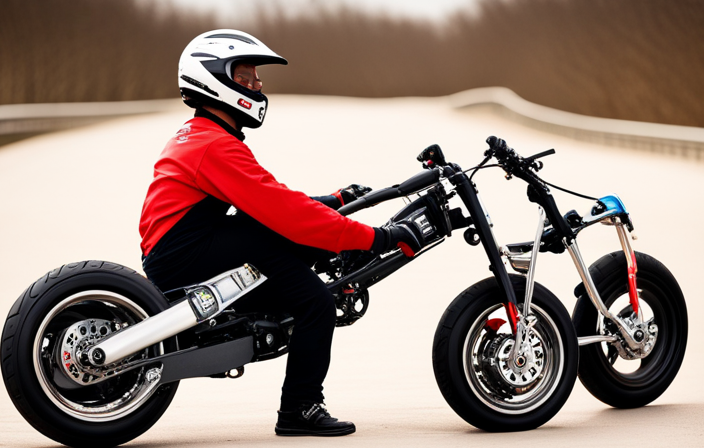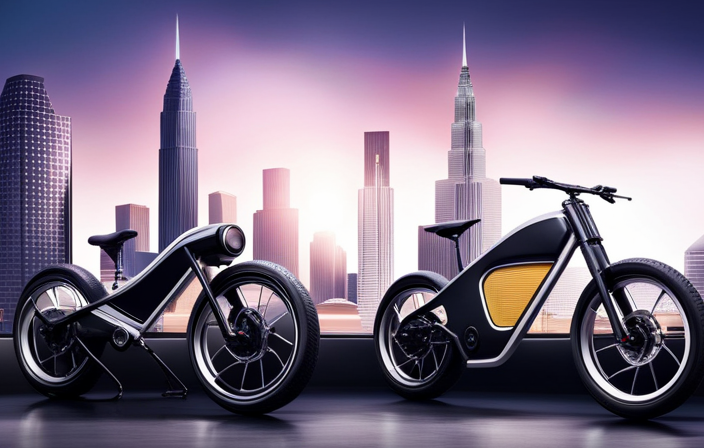Are you feeling frustrated by the restricted power and range of your electric razor pocket bike? It’s time to take control and convert it into a gas-powered version.
In this article, we will guide you through the step-by-step process of transforming your bike into a high-performance machine. From assessing compatibility to installing the gas engine, we will provide you with all the technical details and precise instructions you need.
Get ready to experience the thrill of a gas-powered ride like never before.
Key Takeaways
- Converting an electric razor pocket bike to gas requires engine performance optimization to ensure optimal performance.
- Enhancing the exhaust system is essential to improve airflow and increase power output in a gas conversion.
- Proper clutch adjustment is necessary for maximizing power transfer and ensuring smooth engagement in a gas conversion.
- Optimization of sprocket and gear ratios can help find the ideal balance between acceleration and top speed in a gas conversion.
Assess Your Bike’s Compatibility
Before you start the conversion process, make sure your bike’s components are compatible with a gas engine. Check if your electric razor pocket bike has a strong and sturdy frame that can handle the added weight and power of a gas engine. Ensure that the bike’s tires, brakes, and suspension system are in good condition and can handle the increased speed and torque.
Additionally, make sure that the bike has enough space to accommodate the gas engine, fuel tank, and exhaust system without any interference with other components. It is crucial to assess these factors to ensure a successful conversion and avoid any potential issues or accidents.
Once you have confirmed your bike’s compatibility, you can proceed to gather the necessary tools and parts for the conversion process.
Gather the Necessary Tools and Parts
To successfully convert your electric razor pocket bike to gas, you will need a list of tools and parts.
Start by making a comprehensive list of the tools required for the conversion, including wrenches, screwdrivers, and pliers.
Additionally, research and purchase the necessary gas engine and conversion kit specifically designed for your pocket bike model.
Make a list of tools needed for the conversion
You’ll need a wrench, screwdriver, and pliers for the conversion of your electric razor pocket bike to gas.
Here is a list of tools you’ll need:
-
Wrench: This will be essential for loosening and tightening various nuts and bolts during the conversion process.
-
Screwdriver: You’ll need a screwdriver to remove any screws securing parts that need to be replaced or modified.
-
Pliers: Pliers will come in handy for gripping and manipulating wires, connectors, and other small components.
These tools are crucial for disassembling the electric components of your pocket bike and installing the necessary gas engine and conversion kit.
Once you have gathered these tools, you can move on to the next step of the process: researching and purchasing the required gas engine and conversion kit.
With these tools, you’ll be well-equipped to tackle the conversion process with precision and efficiency.
Research and purchase the required gas engine and conversion kit
Once you’ve gathered the necessary tools, it’s time to research and purchase the gas engine and conversion kit for your pocket bike.
Start by considering the engine size and type that will best suit your needs. Look for an engine that is specifically designed for pocket bikes and has a good reputation for reliability and performance.
Ensure that the conversion kit includes all the necessary components, such as the carburetor, exhaust system, fuel tank, and mounting brackets. Read reviews and compare prices from different suppliers to find the best deal.
Once you have made your purchase, you can move on to the next step of the conversion process, which is to remove the electric components and prepare the bike for the installation of the gas engine.
Remove the Electric Components
First, disconnect the battery and detach the electric components from the pocket bike. This is an important step in converting your electric razor pocket bike to gas. Follow these instructions carefully to ensure a smooth transition:
- Remove the battery: Locate the battery compartment and disconnect the cables. Carefully remove the battery from its housing.
- Disconnect the motor: Locate the motor and disconnect any wires or connectors attached to it. Take note of the motor’s position for reassembly.
- Remove the controller: Find the controller unit and disconnect any wires connected to it. Take care not to damage the wires or connectors during this process.
Now that you have successfully removed the electric components, you can move on to preparing the bike frame for the gas conversion.
Transition: With the electric components safely detached, it’s time to prepare the bike frame for the gas conversion.
Prepare the Bike Frame
Now that you’ve successfully removed the electric components from your electric razor pocket bike, it’s time to prepare the bike frame for the gas engine installation.
This step is crucial to ensure a secure and stable foundation for the new engine.
Begin by inspecting the frame for any signs of damage or wear. Check for loose bolts or screws and tighten them if necessary.
Next, clean the frame thoroughly using a degreaser to remove any dirt, grime, or oil residue that may interfere with the installation process.
Additionally, consider reinforcing weak spots or areas prone to stress with additional support brackets or welds.
Install the Gas Engine
To begin, make sure the bike frame is securely fastened before installing the engine. This is crucial to ensure a stable and safe ride.
Follow these steps to successfully install the gas engine on your electric razor pocket bike:
- Gather all the necessary tools and equipment, including a wrench set and a socket set.
- Locate the mounting points on the frame where the engine will be attached.
- Align the engine with the mounting points and secure it using the provided bolts and nuts.
- Tighten the bolts with a wrench to ensure a firm connection.
- Double-check the engine’s position and make any necessary adjustments.
With the gas engine securely installed, you can now move on to installing the necessary components to get your pocket bike up and running.
Transitioning smoothly into the next section, let’s now focus on installing the essential components for optimal performance.
Install the Necessary Components
Make sure you have all the required components ready before proceeding with the installation.
First, you will need a gas engine suitable for your electric razor pocket bike. Check the specifications to ensure it is compatible with the bike’s frame and power output.
Next, gather the necessary tools, including wrenches, screwdrivers, and pliers, to assist with the installation process.
Additionally, you will need a fuel tank, fuel lines, and a carburetor to ensure proper fuel delivery. Remember to consult the manufacturer’s instructions for the specific model of gas engine you are installing, as there may be additional components required.
Once you have all the necessary components, you can proceed to adjust and test the engine to ensure optimal performance.
Adjust and Test the Engine
Once you’ve gathered all the necessary components, it’s time to adjust and test the engine for optimal performance. Here’s what you need to do:
-
Fuel Mixture: Start by adjusting the fuel mixture to ensure the right air-to-fuel ratio. This will allow the engine to run smoothly and efficiently. Use a mixture of gasoline and oil in the recommended ratio provided by the manufacturer.
-
Ignition Timing: Next, check and adjust the ignition timing. This determines when the spark plug fires, and it needs to be set correctly for the engine to operate at its best. Use a timing light to accurately set the timing according to the specifications given by the manufacturer.
-
Carburetor Settings: Finally, fine-tune the carburetor settings. Adjust the idle speed, air-fuel mixture, and throttle response to achieve optimal performance. This will ensure smooth acceleration and efficient fuel consumption.
By following these steps, you can get your converted gas-powered electric razor pocket bike ready for action.
Now, let’s move on to fine-tuning and optimizing its performance even further.
Fine-tune and Optimize Performance
To optimize the performance of your converted electric razor pocket bike, it is crucial to make any necessary adjustments.
This includes fine-tuning various components such as the carburetor, exhaust system, and suspension to enhance overall performance.
Once the adjustments are made, you should thoroughly test the bike’s speed, acceleration, and overall performance to ensure that your modifications have yielded the desired results.
Make any necessary adjustments to improve performance
You can enhance the performance of your electric razor pocket bike to gas conversion by making necessary adjustments. Here are some key areas to focus on:
- Carburetor tuning: Adjust the air-fuel mixture for optimal performance and fuel efficiency.
- Exhaust system upgrade: Install a high-performance exhaust system to improve airflow and increase power output.
- Spark plug replacement: Replace the stock spark plug with a performance one to ensure efficient combustion and better ignition.
- Clutch adjustment: Fine-tune the clutch to engage smoothly and maximize power transfer.
- Sprocket and gear ratio optimization: Experiment with different sprocket sizes and gear ratios to find the best balance between acceleration and top speed.
By addressing these areas, you can significantly improve the overall performance of your converted gas-powered pocket bike.
Next, let’s move on to test the bike’s speed, acceleration, and overall performance, allowing you to fine-tune further if needed.
Test the bike’s speed, acceleration, and overall performance
Now that you have made any necessary adjustments to improve the performance of your electric razor pocket bike, it’s time to put it to the test. Testing the bike’s speed, acceleration, and overall performance is crucial to ensure that it meets your expectations and performs optimally.
To measure these parameters accurately, you can set up a simple test track and use timing equipment. Start by marking a straight track with a length of at least 100 meters. Then, using a stopwatch or a timing system, record the time it takes for the bike to complete the track. Repeat this test multiple times to get consistent results.
In order to present the test results in a more organized manner, you can use the following table to record the data:
| Test Run | Speed (mph) | Acceleration (0-60 mph) |
|---|---|---|
| 1 | ||
| 2 | ||
| 3 | ||
| 4 | ||
| 5 |
Analyzing the data from these tests will give you valuable insights into the bike’s performance and help you identify any areas that need further improvement.
Now that you have thoroughly tested the bike’s speed, acceleration, and overall performance, it’s time to move on to the next crucial step: ensuring safety and compliance.
Ensure Safety and Compliance
Make sure you’re following safety guidelines and meeting all necessary compliance standards when converting your electric razor pocket bike to gas. This step is crucial to ensure your own safety and the safety of others.
Here are four important things to consider:
-
Safety gear: Wear a helmet, gloves, and protective clothing to reduce the risk of injury in case of an accident.
-
Fuel choice: Use the recommended fuel for your gas conversion kit to ensure optimal performance and prevent damage to the engine.
-
Exhaust system: Install a properly functioning exhaust system to minimize emissions and comply with environmental regulations.
-
Maintenance: Regularly inspect and maintain your gas-powered pocket bike to keep it in good working condition and prevent potential issues.
Enjoy Your Gas-Powered Ride!
Now that you’ve successfully converted your pocket bike from electric to gas, it’s time to take it for a test ride.
Strap on your helmet and gloves, and prepare to experience the exhilarating increase in speed and power that a gas engine provides.
Feel the rush as you throttle the engine and zip through the streets, enjoying the newfound performance of your gas-powered ride.
Take your converted pocket bike for a test ride
After you’ve converted your pocket bike to gas, take it out for a test ride and enjoy the new power.
Start by ensuring that the fuel tank is filled with gasoline and the engine is properly lubricated. Put on your safety gear and mount the bike.
Turn the ignition key to start the engine and let it warm up for a few minutes. Engage the clutch and gently release the throttle to accelerate. Feel the surge of power as the gas engine propels you forward.
As you navigate through different terrains, you’ll notice the improved torque and responsiveness. Experience the increased speed and power of a gas engine, allowing you to reach higher top speeds and conquer challenging tracks with ease.
Experience the increased speed and power of a gas engine
Get ready to feel the adrenaline rush as you zoom down the track, experiencing the exhilarating speed and power of a gas engine. With the conversion of your electric Razor pocket bike to gas, you’ll be able to take your riding experience to a whole new level. The gas engine provides increased speed and acceleration, allowing you to reach top speeds in no time. The power of the gas engine gives you the ability to conquer tough terrains and overcome obstacles with ease. Here is a table to showcase the key differences between an electric and gas engine:
| Electric Engine | Gas Engine |
|---|---|
| Slower acceleration | Quick acceleration |
| Limited top speed | High top speed |
| Quieter operation | Louder engine noise |
| Lower maintenance | Regular maintenance required |
| Limited range | Extended range |
Conclusion
Congratulations! You’ve successfully transformed your electric razor pocket bike into a gas-powered machine. Here’s how you did it:
- Carefully assessed compatibility and gathered the necessary tools and parts.
- Removed the electric components from the bike.
- Prepared the bike frame for the gas engine installation.
- Installed the gas engine and made necessary adjustments.
- Tested the engine to ensure it’s working properly.
- Fine-tuned and optimized the performance of the gas engine.
- Ensured safety and compliance measures are in place.
- Now, you can enjoy the exhilarating experience of riding your newly transformed gas-powered pocket bike.
Get ready to feel the power, speed, and freedom that only a gas engine can provide. Happy riding!









